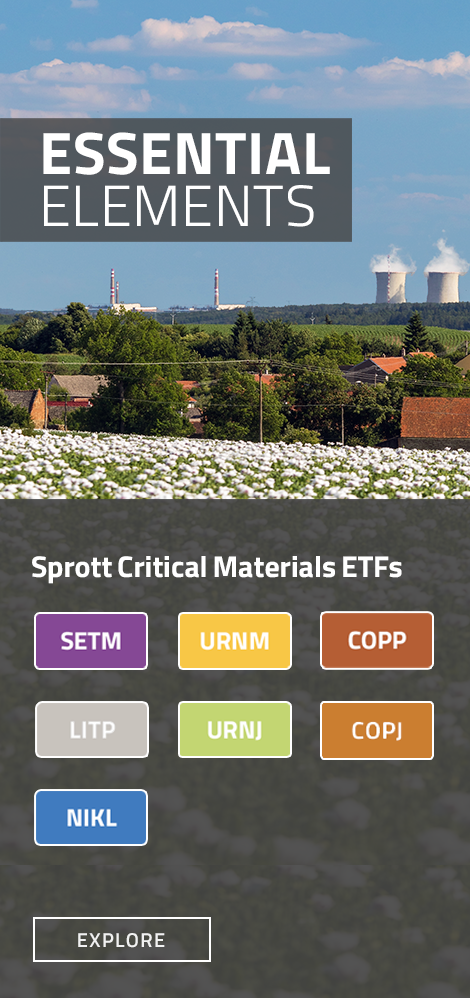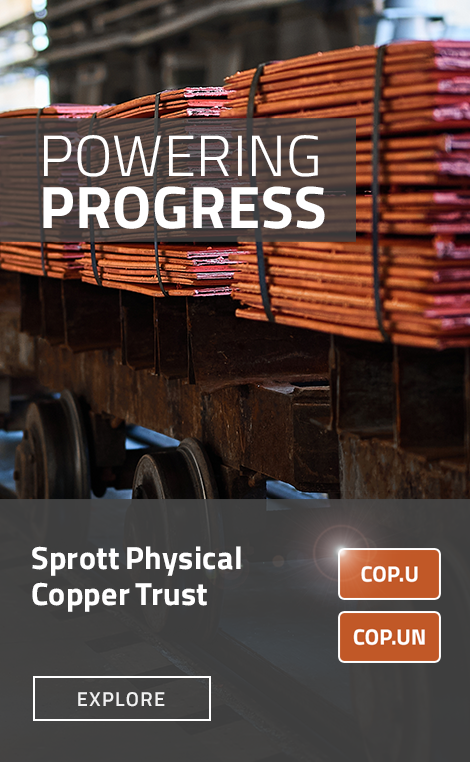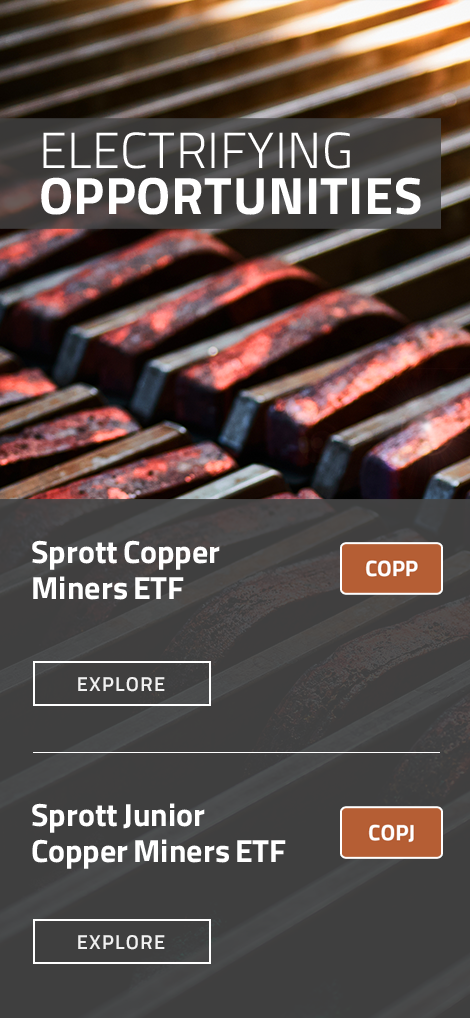July 10, 2024 | 12 mins 14 secs
In this episode of Shifting Energy (Season 1), Thalia Hayden of ETFguide talks with John Ciampaglia, CEO of Sprott Asset Management, about AI's growing energy requirements and how uranium, copper, silver and other metals may benefit.
For the latest standardized performance of the Sprott Energy Transition ETFs, please visit the individual website pages: SETM, LITP, URNM, URNJ, COPP, COPJ and NIKL. Past performance is no guarantee of future results.
Video Transcript
Thalia Hayden: The emerging artificial intelligence industry, also known as AI, is projected to become a trillion-dollar marketplace over the next 10 years. Now, behind that growth are massive infrastructure needs that are required to support the demands of the AI industry. Which metals in the commodities market stand to benefit most, and what ETFs offer an opportunity for investors to participate? Find out right after this.
You're watching Shifting Energy. I'm Thalia Hayden with ETFguide. Thanks so much for joining us. According to Bloomberg Intelligence, with the influx of AI programs like Google's Gemini and open AI's ChatGPT, the AI industry is poised to hit $1.3 trillion over the next 10 years. Now the question is, what will the AI infrastructure build-out look like? Which metals in the commodities market will be needed to support it, and which ETFs offer investors an opportunity to participate in the AI growth trend ahead? John Ciampaglia, CEO at Sprott Asset Management, is helping us answer these questions. Welcome, John. Great to see you again.
John Ciampaglia: Yes, it’s nice to be back.
Thalia Hayden: Let’s get started. Research from Goldman Sachs organized the AI investment opportunity into four phases. It said phase two will involve companies playing a supportive role in helping build AI-related infrastructure. What is your take on this?
John Ciampaglia: The investors have been infatuated with AI over the last year. I think everybody knows NVIDIA is one of the leading chip manufacturers.
What about all these second, third and fourth derivative types of industries and companies that will be important to the build-out? So once you start moving away from the chips, you discuss a lot of infrastructure. I'm not a technology expert, but you're running these very large AI data centers, and there's a lot of equipment in there. Still, I think investors are rightly going further afield from the building and asking the right questions about which industries and companies will benefit from this.
One thing that investors are learning very quickly is that these AI data centers are very energy-hungry. They consume significantly more energy than a typical cloud-based data service that you would use for Google searches or storing digital content in the cloud. Investors are looking at which companies will provide this energy and what kinds of energy. One thing about technology companies is that they're very focused on net zero and low carbon footprints. As you can imagine, they're looking for stable, reliable energy sources to power these data centers. Preferably, they can find clean energy, which would encapsulate things like solar farms with large-scale battery backup storage, nuclear energy in a traditional large-scale format, and small modular reactors, an emerging technology that I think has a role here to play. I think it's fair to say investors are looking at the whole supply chain, trying to figure out which companies will benefit from this build-out over the coming decades.
Thalia Hayden: That certainly makes sense. In your opinion, which metals stand to benefit most from the AI infrastructure build-out?
John Ciampaglia: Let's focus on energy because it's interesting to look at electricity consumption in the United States over the last 50 or 60 years. We had a period of rapid growth as the population was growing and things were industrializing. And then, in about the last 20 years, it's been largely flat. We've had no incremental electricity consumption. Now, the reason for that's quite simple: engineers are very clever and constantly figuring out ways to reduce electricity usage through efficiency and new technologies. Now, if you're thinking about a utility that's been operating in an environment for the last 20 years that has no incremental customer demand, and then all of a sudden, you have a bunch of customers coming to you saying, “Hey, we're going to need a lot more energy from you,” there's a real mismatch right now because the technology of AI is moving so rapidly.
When you contrast that to utilities, which is probably one of the slow-moving industries, in sharp contrast, these utility CEOs are signaling that they're getting requests from their technology company customers and will need more energy down the road. These technology companies are very focused on clean energy. What are the key metals related to that? Silver is a key metal in a solar panel, which most people probably do not know. Copper is very important in terms of connecting all of these things. Large-scale batteries are primarily lithium-ion batteries, so there is another range of different metals in those batteries. And then the second application we're seeing is with nuclear power specifically. And I think there's a good example to highlight.
Just a few weeks ago, Amazon Cloud Services bought a data center from a company called Talen, located right next to a nuclear power station in Pennsylvania. I think it's the perfect example of how they're co-locating these very large data centers next to power sources. They don't want to go to the grid to get power. They want to take it directly from the solar farm that's connected or located very close by, or in some cases, a nuclear power station. So, in nuclear power, the key metal there is uranium, which we've talked about before.
Thalia Hayden: Makes sense. Now, supply and demand imbalances are a big concern as well. With demand for certain metals higher than supply, the AI infrastructure build-out is a major trend, and so is the transition to renewable energy. In your opinion, will the supply side of the metals market meet the demand side?
John Ciampaglia: I think this is a really interesting part of the story here is that as the world is shifting back to a broader range of clean energy technologies, we see, for example, last year in the United States alone, if you look at all the net additions of electricity generation that were added to the grid, 86% of it was non-fossil fuel based. Everything from solar, wind, large-scale batteries, nuclear energy, and technologies are mineral intensive as opposed to fossil fuel. The world has realized that critical minerals are a key part of the story. There are structural supply deficits in key minerals such as uranium. The world is starting to note that copper is another important metal that looks like a supply deficit is building on the horizon as things like clean energy consume ever-increasing amounts. Electric vehicles, which have been growing around the world, are much more copper-intensive. I think the world has realized that we need more copper supply, we need more uranium supply, and we're starting to see the prices of these metals respond in a way you would expect them to, which is they're going up to incentivize these producers to make the necessary investments to ensure we've got security supply long-term. And that's very beneficial for the copper and Iranian mining companies, et cetera.
Thalia Hayden: We got some clarity there. Now, let's switch gears a little bit. S&P Global market intelligence recently reported that companies in the mining sector seek to leverage AI to help with their exploration efforts. For example, Rio Tinto Group is now using virtual mind models to test in-the-field decisions ahead of execution. Do you see this trend continuing?
John Ciampaglia: It’s still in a nascent stage, but I think companies worldwide are trying to figure out how to leverage AI. It's to streamline costs and make their decision-making more efficient and effective. It’s still early days, so understanding how important and valuable these tools will be is hard. But the technology's very powerful and it's changing so quickly. And as the technology evolves, I think it will become more valuable. We're going to see more adoption, which is why these data centers are starting to try to get ahead of the curve, knowing that the deployment is going to accelerate from here and hence the amount of infrastructure and clean energy sources that they're going to need to implement this build-out.
Thalia Hayden: Sprott's ETF lineup offers a lot of choices. How can investors position themselves to participate in the AI infrastructure build-out?
John Ciampaglia: With respect to the metals that I think are going to be the most prominent as part of this theme, it's not just AI; it's a whole host of clean energy technologies and decarbonization technologies. We see two metals playing key roles there, and that's copper just because in a push to electrify everything and move electrons around, whether it's for data centers or energy production, energy transmission, and finally energy storage, copper is the common element across so many different forms of technology and uranium we think is going to be or will remain a very prominent metal because the world is shifting back to nuclear power. And if you think about a data center having to operate all of the time, a nuclear power station is the ideal complement because nuclear energy runs 365, 7 days a week. It provides reliable baseload power that data centers and other technologies need.
We see those two as probably being the most closely linked. And then you've got some battery metals that I think will play secondary roles. About 14% of all the silver each year goes to the production of solar panels, which I think most people would have no idea. Silver is incredibly conductive as a metal, so they put it inside a solar panel. The last metals, I would say, are probably related to lithium-ion batteries because as we build up more solar, they want to store energy when it's readily available at peak sun hours and store it so that they can draw down the energy when the sun isn't shining. We see lithium-ion batteries also playing a key role here.
Thalia Hayden: That's all we have time for. We're going to have to leave it there. But we want to thank you, John, for your valuable insights, and we look forward to seeing you again soon.
John Ciampaglia: Thanks for having me. Appreciate it.
Thalia Hayden: You got it. That does it for today's episode of Shifting Energy. If you enjoyed the show, please tell us in the comments sections below and hit that like button. To learn more about the investment strategies and ETFs we discussed in today's program, you can visit sprottetfs.com. I'm Thalia Hayden with ETFguide. Thanks for watching, and we'll see you next time.
Important Disclosures
An investor should consider the investment objectives, risks, charges and expenses of each fund carefully before investing. To obtain a fund’s Prospectus, which contains this and other information, contact your financial professional, call 1.888.622.1813 or visit SprottETFs.com. Read the Prospectus carefully before investing.
Exchange Traded Funds (ETFs) are considered to have continuous liquidity because they allow for an individual to trade throughout the day, which may indicate higher transaction costs and result in higher taxes when fund shares are held in a taxable account.
The funds are non-diversified and can invest a greater portion of assets in securities of individual issuers, particularly those in the natural resources and/or precious metals industry, which may experience greater price volatility. Relative to other sectors, natural resources and precious metals investments have higher headline risk and are more sensitive to changes in economic data, political or regulatory events, and underlying commodity price fluctuations. Risks related to extraction, storage and liquidity should also be considered.
Shares are not individually redeemable. Investors buy and sell shares of the funds on a secondary market. Only “authorized participants” may trade directly with the fund, typically in blocks of 10,000 shares.
The Sprott Active Metals & Miners ETF, Sprott Active Gold & Silver Miners ETF and the Sprott Silver Miners & Physical Silver ETF are new and have limited operating history.
Sprott Asset Management USA, Inc. is the Investment Adviser to the Sprott ETFs. ALPS Distributors, Inc. is the Distributor for the Sprott ETFs and is a registered broker-dealer and FINRA Member. ALPS Distributors, Inc. is not affiliated with Sprott Asset Management USA, Inc.




